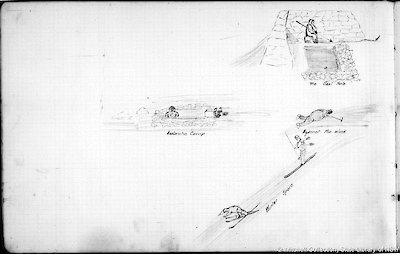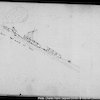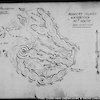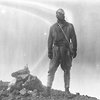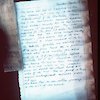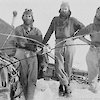Westward ho!
The Western journey was planned on a somewhat smaller scale than its eastern counterpart. The main aim was to reach places visited by the First German Antarctica Expedition under Erich von Drygalski a decade earlier. Then, Drygalski had wintered in the sea ice aboard Gauss and mapped coastal ice formations, including an island and a peak which he named Gaussberg.
Unlike the earlier depot-laying party, the three-man group of Jones, Dovers and Hoadley avoided the sea ice when they set out on 7 November 1912. Their route took them south across the ice shelf to Junction Corner, past the depot laid in October and parallel to the coast, having to battle hard to avoid being blown down on to the sea ice.
They crossed Helen Glacier well inland, managing to avoid the worst of the crevasses, although in crossing a snow bridge unroped Jones and Hoadley were lucky to escape disaster. The bridge collapsed when Dovers crossed, but he was harnessed to his sledge. As usual the weather held them up, but by 24 November they had crossed the Helen.
Next day, looking down to the sea, they had their first sighting of ‘German land’ — Drygalski Island to the north, about 50 kilometres away. They resolved to investigate a group of small coastal islands (later named Haswell Islands, after an AAE committee member). There they stayed, immobilised by a blizzard, for four days.
But unlike their ice-shelf home, here, at least, they had company. Scattered all over the island, wrote Dovers, ‘are Adélie penguin rookeries & on the cliff faces Cape Pigeons, Fulmar Petrels, Antarctic Petrels are breeding, Wilson’s Petrels build under the weathered out slabs of rock, & the Skua Gulls on gravely patches in sheltered corners’.
Looking along the coast from their island vantage point, it became clear that the only sensible route to the west was on the high ground, back from coastal crevasses. So the next few days were an uphill slog until, on 16 December, they sighted ‘a small dark object bearing due west’: Gaussberg.
A crevasse fall by Dovers did little damage to him, but damaged his wrist chronometer which he used for his cartographic observations, throwing into some doubt the accuracy of his estimations of longitude. In a note accompanying Jones’s report, Mawson wrote that Dovers’s errors had been largely eliminated with the help of Gauss and later Aurora records.
Crossing with great difficulty the heavily-crevassed Posadowsky Glacier, the three men reached their ultimate destination. Gaussberg, a striking coastal volcanic cone about 370 metres high, provided a memorable backdrop for a ‘gloriously fine’ Christmas Day:
At midday the Christmas ‘hamper’ was opened, and it was not long before the only sign of the plum-pudding was the tin. In the afternoon we ascended the mountain and left a record in a cairn at the top.
Dovers having recorded the lay of the land to the west, the trio retraced their steps along the plateau. Blizzards around New Years Day were only temporary obstacles, interspersed with good sledging conditions and, on one occasion, a splendid parhelion (‘sun dog’) display, caused by atmospheric ice crystals refracting sunlight. Reaching the Grottoes on 20 January, they were pleased to note that the Eastern party had arrived ahead of them.

